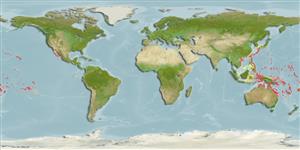>
Blenniiformes (Blennies) >
Tripterygiidae (Triplefin blennies) > Tripterygiinae
Etymology: Enneapterygius: Greek, ennea = nine times + Greek, pterygion = little fin (Ref. 45335); nigricauda: Specific name refers to the black caudal fin of the males..
More on author: Fricke.
Environment: milieu / climate zone / depth range / distribution range
Ökologie
seewasser demersal; tiefenbereich 0 - 11 m (Ref. 27223). Tropical
Western Central Pacific: Taiwan, Philippines, Vanuatu, Tonga, American Samoa, Society Islands, Kiribati, Jarvis Island, Howland Island, Wake Island, Marshall Islands, Micronesia, Guam, and Boni Islands (Japan).
Size / Gewicht / Alter
Maturity: Lm ? range ? - ? cm
Max length : 2.9 cm SL Männchen/unbestimmt; (Ref. 27223)
Rückenflossenstacheln (insgesamt) : 14 - 17; Rückenflossenweichstrahlen (insgesamt) : 7 - 10; Afterflossenstacheln: 1; Afterflossenweichstrahlen: 16 - 19. Male red with darker red, double red bars , black "mask" covering front and lower two-thirds of head, chest, and pectoral-fin base, narrow white bar at caudal-fin base, and basal two-thirds to three-fourths of caudal-fin black. Female translucent greenish grey with indistinct reddish blotches along back, middle of sides, and just above anal-fin base. Head, chest, and pectoral-fin base scaleless; short orbital tentacle present; mandibular pores 3-4 + 1 + 3-4. Maximum size to 3.5 cm TL (Ref. 90102).
Adults are found on seaward and lagoon reefs, usually less than 5 m (Ref. 90102). Eggs are hemispherical and covered with numerous sticky threads that anchor them in the algae on the nesting sites (Ref. 240). Larvae are planktonic which occur primarily in shallow, nearshore waters (Ref. 94114). Minimum depth from Ref. 58018.
Life cycle and mating behavior
Maturities | Fortpflanzung | Spawnings | Egg(s) | Fecundities | Larven
Fricke, R., 1997. Tripterygiid fishes of the western and central Pacific, with descriptions of 15 new species, including an annotated checklist of world Tripterygiidae (Teleostei). Theses Zool. 29:1-607. (Ref. 27223)
IUCN Rote Liste Status (Ref. 130435)
Bedrohung für Menschen
Harmless
Nutzung durch Menschen
Tools
Zusatzinformationen
Download XML
Internet Quellen
Estimates based on models
Preferred temperature (Ref.
123201): 24.6 - 29.3, mean 28.3 °C (based on 1661 cells).
Phylogenetic diversity index (Ref.
82804): PD
50 = 0.5000 [Uniqueness, from 0.5 = low to 2.0 = high].
Bayesian length-weight: a=0.00562 (0.00258 - 0.01228), b=3.08 (2.89 - 3.27), in cm total length, based on LWR estimates for this (Sub)family-body shape (Ref.
93245).
Trophic level (Ref.
69278): 3.1 ±0.3 se; based on size and trophs of closest relatives
Widerstandsfähigkeit (Ref.
120179): hoch, Verdopplung der Population dauert weniger als 15 Monate. (Preliminary K or Fecundity.).
Fishing Vulnerability (Ref.
59153): Low vulnerability (10 of 100).
